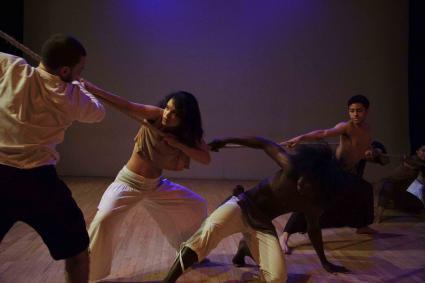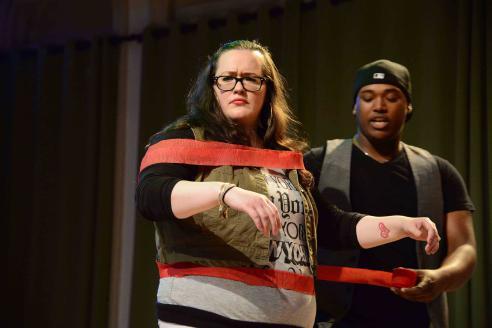Tonight I'm witnessing history merge with the future as young artists break ground at one of New York's most hallowed institutions. As the heavy double doors of University Settlement swing open to welcome a diverse crowd off the dusky Lower East Side streets, there is a sense of entering a liminal sacred space. Here one transcends time and circumstance to create miracles; here beats the heart of the American Dream.
Founded in 1886, University Settlement (US) is the country's oldest multi-generational social service organization, dedicated to supplying low-income families with comprehensive support, decent housing, and quality education of all kinds. Its sister facility The Door, New York's premier youth development organization, focuses on wraparound services for displaced and at-risk teens and young adults. Both establishments offer resources such as job training, after-school programs, and legal counseling, but they also place a special emphasis on exposure to the arts.
"It makes terrific sense to value the arts in our postindustrial global world," says US's Arts Director Alison Fleminger. "We have plenty of data to prove that the arts create more college graduates, more mentally and physically healthy people and engaged citizens... What we lack is an understanding of how to design empowered creative communities that can accelerate the change [society] desperately needs."
To that end, Fleminger has produced Making Space for Downtown Dreams, the first collaborative benefit performance of its kind at US. Directed by her colleague at The Door, Anthony Rodriguez (an acclaimed choreographer and featured soloist on Madonna's Drowned World tour), Making Space is a powerful anthology of multimedia movement-based pieces about overcoming adversity through artistic expression. Various young adult ensemble groups -- ages 16 to 21 -- from both institutions have joined together to exhibit the creative training they've received and to heighten awareness of the vital role the arts can play in changing a life.
The show begins with a sobering statistic: 20 percent of New York's public schools are entirely without arts funding, programming, or teachers. Suddenly video footage rolls, giving the audience a glimpse of everything imaginative US and The Door can provide: dance, music, writing, painting, drama. As the soundtrack grows more triumphant, lithe enthusiastic bodies emerge from each corner of the room, and soon the stage is filled with the newest members of The Door Dance Intensive leaping and whirling in soulful rhythm. Their passion is palpable and hypnotic -- Yes, the audience cries, That's exactly why we're here!
Rodriguez later tells me that it's the first time onstage for many of these performers, which makes their total commitment to the project doubly inspiring. He notes that creating the show was "a completely collaborative" experience, for although Rodriguez helmed Making Space and his flamenco background quite clearly influenced dance pieces like "Breakin' Free" (a beautiful segment using tug-of-war as an allegory for poverty), the teens themselves contributed a lot of content. One memorable sketch called "Back to the Future," about Millennial rappers who travel back to 1990, was written entirely by the young men of Lyrical Masterminds, The Door's newest rap collective, under the supervision of staff leader James "SoSoon" Gantt. Other vignettes crafted by staff leaders include the song-and-dance numbers from the Young Arts Intensive (Marguerite Hemmings and Ian Foster Jones), haunting Dance Intensive solos (Julius Rubio), and an inventive step routine from the Hit Squad (Moet Mendez) reminding those present that it takes all parts to make a whole.
"We Make Space," a spoken-word sketch developed through Fleminger's own Play Tank initiative, particularly helps drive home the evening's message. A man and woman extol the virtues of arts education; the woman then invites the audience to several locations where such programming has been set up, only for the man to inform her that funding has been cut and to physically restrain her with red tape until she's rendered immobile. A bit on the nose perhaps, but nevertheless incredibly moving, especially when the man concludes: "It is our job to help our kids see the light that is inside of them because they are so easily distracted by the things that are not as important as them. We make space."
I learn afterward that Angel Sacarello, who speaks this line, is himself a product of the settlement house system, having attended programs and camps with US since the age of six. Now he and his fellow actor Tina Stumpf are teachers at US paying it forward. It's a perfect example of how accessibility to the arts can turn a child's life around and achieve a ripple effect. US and The Door strive for ripple effects every day.
Fleminger believes her programming is essential for children who wouldn't otherwise be exposed to it, and she observes that when they begin teaching art themselves, as Sacarello does, it can help them conquer their fear of the unknown: "They're healing from the wounds of the [public] educational system; they come here and there's a little poetry in getting involved in what scares them most."
Poetry radiates from each gesture, beat, and word in Making Space for Downtown Dreams. Executive Director Melissa Aase caps the performance with a short tribute to US's storied legacy and the assertion, "When they built this space, they built it for tonight!"
Near the tail end of the night, during the after-party at the Erste Warshower Synagogue (now an extraordinary studio privately owned and operated by artist Hale Gurland), Fleminger, Rodriguez, and Aase toast the success of this debut grand experiment. It has taken an enormous amount of rehearsal, they admit with a laugh -- Rodriguez sheepishly confesses to being a bit of a taskmaster -- but seeing its impact on both the supporters and the young participants is a reward beyond measure.
Gurland, a longtime US board member, states succinctly, "An artist is a person who, whatever medium they use, changes the way you think about the world."
And so we must do everything possible to maintain these designated creative spaces and prevent them from disappearing. Everyone deserves a chance to discover the artistic powers within.
The emerging artists from US and The Door have certainly made an indelible impression on how I think about the world -- here's hoping they continue to do so for a lifetime.


